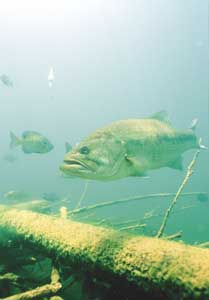
Unless you like to striper fish, or if you only want to fish if you can find a nice warming trend, it’s going to be tough to catch many fish this month. January is usually an extremely tough month because the water is so cold, and a lot of the time, it’s dirty. So to have any kind of chance to find any decent numbers of fish, you’re going to have to fish a lake with a warm-water discharge like Wylie, Norman, Belews Creek or Hyco.
Those lakes, because of the way the power plants the run are set up, have areas where water is taken out of the lake, run through the plant to make electricity or cool off generators, then returned to the lake a great deal warmer.
The little creeks or cuts where that warm water is flushed back into the lake are warm-water discharges, known better to fishermen as “hot holes.”
A lot of people are very successful catching fish in January because they head to warm-water discharges, where they’re fishing in 70-degree water when it’s 25 degrees outside. Fish in that kind of water will always be more active, and just about the only thing that can ruin your day is if there’s a lot of fishing pressure there the day you’re planning to fish. Even when conditions are right, it’s hard to catch fish in a crowd.
But you just don’t show up, turn on the temperature gauge on your depthfinder and head for the warm-water discharge. There are a few things that will help you catch a fish or two more than anybody else is.
First of all, even though the water is warm, you still need to fish slowly. I’ve fished the warm-water discharges at Wylie and Norman, and even though they’ve got warm water coming out, the fish still seem to want baits worked very slowly, either slow-rolling a spinnerbait or working a crankbait with a wide wobble very slowly – something like a DT-6 or a Wiggle Wart.
You don’t wind the bait like you’d wind it during the summer. You have to be more persistent with it. If you’re fishing a laydown, you don’t just throw in there a time or two; you throw in there 15 or 20 times before you move. Even though the water is warmer, you have to fish a little more slowly.
Also, you don’t need to be right in the hot hole to catch fish. There are probably more fish sin there where the warmest water is, but the effects of the warm water can be felt quite a ways away from the actual discharge, because the wind can create a current that sends that warmer water off in different directions. What I want to do is get on the outside of the warm-water discharge area; I want to find the place where the warm water meets the cold water. There will usually be a very distinct edge there. I might be sitting in 50-degree water, but if I move, say, three or four lengths of my Ranger boat, I can be in 65-degree water. That’s the kind of edge I’m looking for, because a lot of fish, and bigger fish, will hold very close to that temperature change.
Because baitfish are drawn to the warm water almost as much as the gamefish are, I want to match the color of my baits to those baitfish. I’m almost always going to fish some sort of shad pattern.
And another key is to fish a big bait. A lot of times, you’ll find those great big gizzard shad up in that hot water in good numbers. You’ve got so many big shad in there that the bass will key on that size. If you throw a bait, you want to make it a big one.
Rapala has made, for years, a Super Shad Rap, a bait that seems like it’s about 10 inches long. That’s a good bait for this kind of situation. You can really catch some big fish with it.
If you’re fishing a spinnerbait, you want to fish a bulky bait with a long trailer. I normally use a Zoom Critter Crawler for a spinnerbait trailer, but in the winter,
I’ll just use the bigger version of that bait, and I’ll make sure I use big blades. When it comes to plastics, if I normally fish a 6-inch lizard, I’ll use an 8-inch lizard, because those big baits work in the winter.
Bass in the winter normally don’t feed much, so they have to be much more efficient when they feed. They want to take one big bite and not have to feed for the rest of the day, and that’s why big baits appeal to them. And that’s also why you can catch some of your biggest fish of the year in the winter — because those bigger fish key on bigger baits.
Where you might not get great numbers of fish in January, you can get real quality ones.
Editor’s note: David Fritts is a 49-year-old professional bass fisherman from Lexington. He was the 1993 BASS Masters Classic champion, the 1993-94 BASS Angler of the Year and the 1997 FLW Tour Champion. His sponsors include: Bass Pro Shops, Evinrude Motors, Ranger Boats, Chevy Trucks, Minn-Kota trolling motors, American Rodsmith, Rapala crankbaits and fishing line, Zoom plastics, Solar Bat sun glasses, Mountain Dew, Gripper (ECS Anchor Supply), VMC hooks, Pro Pocket and Blue Fox.




Be the first to comment